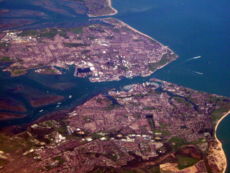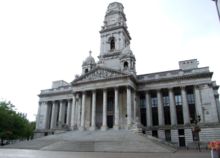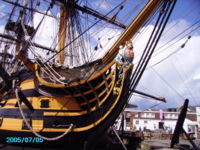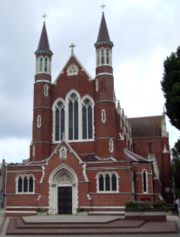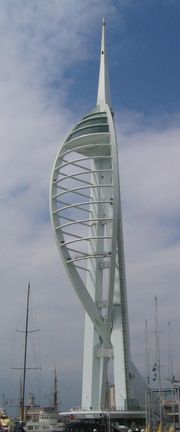Portsmouth
2007 Schools Wikipedia Selection. Related subjects: Geography of Great Britain
| City of Portsmouth | |
|---|---|
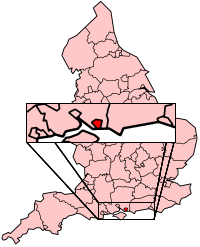 |
|
| Geography | |
| Status: | Unitary, City (1926) |
| Region: | South East England |
| Ceremonial County: | Hampshire |
| Area: - Total |
Ranked 319th 40.25 km² |
| Admin. HQ: | Portsmouth |
| ONS code: | 00MR |
| Demographics | |
| Population: - Total (2005 est.) - Density |
Ranked 75th 189,600 4,711 / km² |
| Ethnicity: | 93.7% White 4.5% S.Asian |
| Politics | |
 Portsmouth City Council http://www.portsmouth.gov.uk/ |
|
| Leadership: | Leader & Cabinet |
| Executive: | Liberal Democrats |
| MPs: | Mike Hancock, Sarah McCarthy-Fry |
Portsmouth is a city of about 189,000 people located in the county of Hampshire on the southern coast of England. The administrative unit itself forms part of the wider Portsmouth conurbation, with an estimated population of 442,252 residents within its boundaries, making it the 11th largest urban area in England. A significant naval port for centuries, it is home to the world's oldest dry dock still in use and to many famous ships.
Portsmouth has declined as a military port in recent years but remains a major dockyard and base for the Royal Navy. There is a commercial port serving destinations on the continent for freight and passenger traffic.
The Portsmouth Urban Area covers an area with a population well over twice that of the city of Portsmouth itself, and includes Southsea, Fareham, Portchester, Gosport, Havant (which includes the large suburb Leigh Park), Lee-on-the-Solent, Stubbington and Waterlooville.
History
Early history of the area
Although there have been settlements in the area since before Roman times, mostly being offshoots of Portchester, Portsmouth is commonly regarded as having been founded in 1180 by John of Gisors ( Jean de Gisors). Most early records of Portsmouth are thought to have been destroyed by Norman invaders following the Norman Conquest. The earliest detailed references to Portsmouth can be found in the Southwick Cartularies. However the Oxford Dictionary of British Place Names gives the name "Portesmuthan" as late 9th century, meaning "mouth of the harbour called Port" (from Latin portus).
In the Domesday survey there is no mention of Portsmouth. However settlements that later went on to form part of Portsmouth are listed. These are Buckland, Copnor, Fratton on Portsea Island and Cosham, Wymering, Drayton and Farlington on the mainland. At this time it is estimated the Portsmouth area had a population not greater than two or three hundred.
While in the primary diocese of Portsea there was a small church prior to 1166 (now St Mary's in Fratton) Portsmouth's first real church came into being in 1181 when John of Gisors granted an acre (4,000 m²) of land to Augustinian monks at the Southwick Priory to build a chapel dedicated to Thomas Becket. This chapel continued to be run by the monks of Southwick Priory until the Reformation after which its possession was transferred to Winchester College. The modern Portsmouth Anglican Cathedral is built on the original location of the chapel.
Growth of the city
In 1194, after King Richard I (the Lionheart) returned from being held captive by Duke Leopold V of Austria, Richard set about summoning a fleet and an army to Portsmouth, which Richard had taken over from John of Gisors. On May 2, 1194 King Richard I gave Portsmouth its first Royal Charter granting permission for the city to hold a fifteen day annual fair (which became known as the Free Market Fair), weekly markets (on Thursdays), to set up a local court to deal with minor matters, and exemption from paying the annual tax ("farm") of £18 a year--instead the money would be used for local matters. The actual physical charter was handed over by the Bishop of Ely William de Longchamps. The present location of the charter is currently unknown but its text survives, as when later royal charters were granted to the city reaffirming and extending its privileges large parts of the original charter were quoted verbatim.
As a crescent and an eight-point star (as appear on the city coat of arms) were to be found on both the seals of King Richard and William de Longchamps it is commonly thought that this may have been the source of them, although there is no known documentary evidence for this.
King Richard later went on to build a number of houses and a hall in Portsmouth, the hall is thought to have been at the current location of the Clarence Barracks (the area was previously known as Kingshall Green).
In 1200 King John issued another charter to Portsmouth reaffirming the rights and privileges awarded by King Richard. King John's desire to invade Normandy resulted in the establishment of Portsmouth as a permanent naval base.
In 1212 William of Wrotham (Archdeacon of Taunton, Keeper of the King's Ships) started constructing the first docks of Portsmouth. At about the same time Pierre des Roches (Bishop of Winchester) founded Domus Dei (Hospital of St Nicholas) which performed its duties as an almshouse and hospice until 1540 when like other religious buildings it was seized by King Henry VIII).
During the thirteenth century Portsmouth was commonly used by King Henry III and Edward I as a base for attacks against France.
By the fourteenth century commercial interests had grown considerably, despite rivalry with the dockyard of nearby Southampton. Common imports included wool, grain, wheat, woad, wax and iron, however the ports largest trade was in wine from Bayonne and Bordeaux.
War with France
In 1338 a French fleet led by Nicholas Behuchet arrived at Portsmouth docks flying English flags before anyone realised that they were a hostile force. The French burnt down most of the buildings in the town and many of the population were raped and slaughtered, only the local church and Domus Dei survived. As a result of this King Edward III gave the remaining townsfolk exemption from national taxes so that they could afford to rebuild the town.
Only ten years after this devastation the town for the first time was struck by the plague known as the Black Death. In order to prevent the regrowth of Portsmouth as a threat the French again sacked the city in 1369, 1377 and 1380.
King Henry V was the first king to decide to build permanent fortification in Portsmouth. In 1418 he ordered a wooden Round Tower be built at the mouth of the harbour, which was completed in 1426. However it wasn't until the Tudor dynasty that Portsmouth's defence was seriously dealt with. Under King Henry VIII the Round Tower was rebuilt out of stone and a Square Tower was raised. It was at this time that Robert Brygandine and Sir Reginald Bray, with the support of the king, commenced the building in Portsmouth of the country's first dry dock. In 1527 with some of the money obtained from the dissolution of the monasteries Henry VIII built the fort which became known as Southsea Castle. In 1545, he saw his vice- flagship Mary Rose founder off Southsea Castle, with a loss of about 500 lives, while going into action against the French fleet.
Over the years Portsmouth's fortification was increased by numerous monarchs including King Henry VII and Queen Elizabeth I, although most of these have now been converted into tourist attractions.
On December 21, 1872 a major scientific expedition, the Challenger expedition, was launched from Portsmouth.
20th century
In 1904 the boundaries of Portsmouth were extended to finally include the whole of Portsea Island. The boundaries were further extended in 1920 and 1932, taking in areas of the mainland.
The city was bombed extensively during WW2, destroying many houses and the Guildhall. While most of the city has since been rebuilt, developers still occasionally find unexploded bombs.
Southsea beach and Portsmouth Harbour were military embarkation points for the D-Day landings on June 6th 1944. Southwick House, just to the north of Portsmouth, had been chosen as the headquarters for the Supreme Allied Commander, General Eisenhower during D-Day.
After the war, much of the city's housing stock was damaged and more was cleared in an attempt to improve the quality of housing. Those people affected by this were moved out from the centre of the city to new developments such as Paulsgrove and Leigh Park.
21st century
In 2003, erection was started of a 170 metre high Spinnaker Tower sited at Portsmouth Harbour, and celebrating the city's maritime tradition. Completed in 2005, the tower has twin concrete legs meeting at half height to form a single column from which steel sails are mounted; an observation deck at the top provides a view of the city and harbour for tourists.
In late 2004, Tricorn Centre, dubbed "The ugliest building in the UK" was finally demolished after years of delay and wrangling over the cost of doing so and the controversy as to whether it was worth preserving as an example of sixties Brutalist architecture.
In 2005, Portsmouth was a focus for Sea Britain, a series of events to mark the 200th anniversary ( bicentenary) of Lord Nelson's victory at the Battle of Trafalgar. In particular, in June, there was the massive Fleet Review, by HM Queen Elizabeth II and a mock battle ( son et lumière) that evening, after dark.
Economy
This is a chart of trend of regional gross value added of Portsmouth at current basic prices published (pp.240-253) by Office for National Statistics with figures in millions of British Pounds Sterling.
| Year | Regional Gross Value Added | Agriculture | Industry | Services |
|---|---|---|---|---|
| 1995 | 2,023 | - | 496 | 1,528 |
| 2000 | 2,750 | - | 658 | 2,092 |
| 2003 | 3,362 | - | 705 | 2,657 |
- ^ Components may not sum to totals due to rounding
- ^ includes hunting and forestry
- ^ includes energy and construction
- ^ includes financial intermediation services indirectly measured
Geography
Most of the city of Portsmouth lies on Portsea Island, located where the Solent joins the English Channel. This makes Portsmouth the United Kingdom's only island city and one of the most densely populated places in Europe. The island is separated from the mainland to the north by a narrow creek, bridged in places to make it - in appearance - a peninsula. The sheltered Portsmouth Harbour lies to the west of the island and the large tidal bay of Langstone Harbour is to the east. Portsdown Hill dominates the skyline to the north, providing a magnificent panoramic view over the city, and to the south are the waters of the Solent with the Isle of Wight beyond. Being a seaside city, it is low-lying -- majority of its surface area less than 3 metres above sea level.
The city includes the following districts on the island:
- Baffins
- Buckland
- Copnor
- Eastney
- Fratton
- Hilsea
- Kingston
- Landport
- Milton
- North End
- Old Portsmouth
- Portsea
- Rudmore
- Somerstown
- Southsea
- Stamshaw
- Tipner
And these districts on the mainland:
- Cosham
- Drayton
- Farlington
- Paulsgrove
- Widley (a small part of)
- Wymering
Education
Higher and further education
The city has one university, the University of Portsmouth (previously Portsmouth Polytechnic), but several local colleges also have the power to award HNDs.
Local further education colleges include Highbury College, the largest, which specializes in vocational education and Portsmouth College, which offers a mixture of academic and vocational courses in the city. Additionally there is South Downs College and Havant College, both of which offer a range of academic and vocational courses available just outside the city.
Secondary education
Local secondary schools are Admiral Lord Nelson School, City of Portsmouth Girls' School, King Richard School, Mayfield School, Milton Cross School, Priory School, Springfield School, St Edmund's RC School, St Luke's CofE VA Secondary School and City of Portsmouth Boys' School.
Independent schools include the Portsmouth Grammar School, Mayville High School, Portsmouth High School and St John's College.
Both Admiral Lord Nelson School and Milton Cross School were built recently to meet the demand of a growing young population.
Government
The city is administered by Portsmouth City Council, which is currently a unitary authority. Until April 1, 1997 it was a non-metropolitan district of Hampshire. Portsmouth remains part of the Ceremonial county of Hampshire.
The city council is made up of 42 councillors. These are returned from 14 wards, each ward having three councillors. The wards are Baffins, Central Southsea, Charles Dickens, Copnor, Cosham, Drayton and Farlington, Eastney and Craneswater, Fratton, Hilsea, Milton, Nelson, Paulsgrove, St. Jude and finally St. Thomas. Where a ward is named after an area of the city, it will also include parts not considered part of the traditional area.
Shopping
In the last decade the number of shops in Portsmouth has grown dramatically due to both the buoyancy of the local economy and improved transport links.
Shopping areas in the city include:
- Ocean Retail Park is an out-of-town shopping area located on the north eastern side of Portsea Island off the A2030 leading to the A27. It is close to the site of the old Portsmouth Airport that closed in 1973. The retail park is composed of shops requiring large floor space for selling consumer goods (furniture, electrical goods, computers).
- Cascades Shopping Centre an indoor shopping centre built in the early nineties with approximately 75 shops covering a wide range of goods.
- Commercial Road running alongside the Cascades shopping centre this area contains approximately a further 50 shops, located near Portsmouth & Southsea train station.
- Gunwharf Quays a new shopping area which opened in 2001 consists of 85 mainly upmarket fashion stores, restaurants and a Vue multi-screen cinema, located near Portsmouth Harbour train station and the Hard Bus Interchange, and a relatively short walk from Commercial Road.
- Bridge Centre a 11,043 square metre shopping centre built in 1988, now dominated by the newly built Asda Walmart store.
- The Historic Dockyard has several shops of interest, selling mainly goods with a nautical theme and with Victory or Mary Rose connotations. It also has a French Market, several times per year and a Christmas Market each year, in the lead-up to Christmas.
Other shopping areas with more than twenty shops include North End, Fratton Road, Palmerston Road, Elm Grove/Albert Road, and Cosham High Street.
Portsmouth is considered by some to be a clone town, particularly the town centre.
Sport
The city is home to Portsmouth F.C., who play their home games at Fratton Park. Having secured planning permission, the club are in the process of building a new stadium on the same site.
Locks Sailing Club at Longshore way is the city's premier dinghy sailing club. Portsmouth Rugby Football Club play their home games in the London Division at Rugby Camp, Hilsea.
The city's rowing club is located in Southsea at the Seafront near the Hovercraft Terminal.
Tourist Attractions
Most of Portsmouth's tourist attractions are related to its naval history. In the last decade Portsmouth's Historic Dockyard has been given a much needed face-lift. Among the attractions are the D-Day museum (which holds the Overlord embroidery) and, in the dockyard, HMS Victory, the remains of the Mary Rose raised from the sea-bed in recent years, HMS Warrior and the Royal Naval Museum.
The millennium project to build the Spinnaker Tower at Gunwharf Quays was completed in 2005. The tower is 170 m tall, features viewing decks at sea level, 100 m, 105 m, and 110 m.
Other tourist attractions include the birthplace of Charles Dickens, the Blue Reef Aquarium (formerly Sea Life Centre), Cumberland House (a natural history museum), and Southsea castle.
Places of worship
Portsmouth is almost unique among British cities in having two cathedrals; the Anglican Cathedral of St Thomas, in Old Portsmouth, and the Roman Catholic Cathedral of St John the Evangelist, in Edinburgh Road, Portsea. The historic reason for this is that when Catholics were permitted to re-establish cathedrals in the UK in the nineteenth century, they were only allowed to do so in places without an existing Church of England cathedral, e.g. Birmingham, Arundel, Southwark, Westminster and Salford. This restriction has now been abolished, as at Liverpool and Bristol (Clifton). Portsmouth's Catholic cathedral was consecrated in 1882. Later, when Portsmouth was raised to city status in 1926, St Thomas' Church was also raised to cathedral status. When St Mary's Church, Portsea, was rebuilt in Victorian times, it had been envisaged that it might be the cathedral if city status was achieved, but St Thomas' was given the honour because of its historic status. Another historic Old Portsmouth church, the Garrison Church, was bombed during the war and the nave has been left roofless as a memorial. There are numerous other active churches and places of worship throughout the city (see links at end for some websites).
Transport and communications
The city has several mainline railway stations, on a direct route to London. Portsmouth's stations are (in order, out of the city): Portsmouth Harbour, Portsmouth & Southsea, Fratton, Hilsea and Cosham.
Portsmouth Harbour has passenger ferry links to Gosport and the Isle of Wight. A car ferry service to the Isle of Wight operated by Wightlink is nearby. Britain's longest-standing commercial hovercraft service, begun in the 1960's, still runs from near Clarence Pier to Ryde, Isle of Wight, operated by Hovertravel.
Local Bus services are provided by First in Hampshire & Dorset and Stagecoach serving the City of Portsmouth and the surroundings of Havant, Leigh Park, Waterlooville, Fareham and long distance service 700 to Chichester, Worthing and Brighton
There are three road links to the mainland. These are the M275, A3 (London Road) and A2030 (Eastern Road).
Portsmouth Continental Ferry Port has links to Caen, Cherbourg-Octeville, St Malo and Le Havre in France, Bilbao in Spain and the Channel Islands. Ferry services from the port are operated by Brittany Ferries, P&O Ferries, Condor Ferries and LD Lines. On 18 May 2006 Acciona Trasmediterranea started a service to Bilbao in competition with P&O’s existing service. This service got off to a bad start when the ferry 'Fortuny' was detained in Portsmouth by the MCA for numerous safety breaches. The faults were quickly corrected by Acciona and the service took its first passengers from Portsmouth on the 25 May 2006. The port is the second busiest ferry port in the UK after Dover handling around 3 million passengers a year and has direct access to the M275.
There is an ongoing debate on the development of public transport structure, with monorails and light rail both being considered. A light rail link to Gosport has been authorised but is unlikely to go ahead following the refusal of funding by the Department for Transport in November 2005. The monorail scheme is unlikely to proceed following the withdrawal of official support for the proposal by Portsmouth City Council, after the development's promoters failed to progress the scheme to agreed timetables.
The telephone area code for Portsmouth is 023 followed by an eight digit number (usually beginning with 92), and was previously (01705), and before that (0705).
Future developments
Development at Gunwharf Quays will continue until 2007 with the completion of Portsmouths tallest building at 29 storeys East Side Plaza. Development of the former Brickwood brewery site, now under way, will include a 22 storey tower know as the Admiralty Quarter Tower.
Portsmouth's regeneration is being continued in the city centre with the controversial demolition of the Tricorn Centre, a long abandoned shopping mall and car park, described as a "concrete monstrosity".
The site is due to be transformed by 2010 to include shops, cafés and restaurants, a four-star 150-bed hotel, 200 residential apartments, and a 2,300-space car park.
The rebuilding of Fratton Park, home to Portsmouth Football Club is set to hold 35,000 fans. The stadium will be built to allow Portsmouth to compete successfully in the English Football's Premier League. Along with the stadium, 500 houses will be built in a development called Pompey Village.
These plans have been superseded by plans to build a 40,000+ capacity stadium. The club is currently in negociations with Portsmouth City Counicl to try to find another site with better road access and more space for other development. Possible locations are:
- King George V playing fields - Cosham,
- St Johns playing fields - Farlington,
- Tipner,
- Fratton Park
Lists
Chronology
- 1181 - Establishment of a church.
- 1194 - Portsmouth awarded its Royal Charter
- 1212 - Establishment of docks.
- 1212 - Domus Dei the first hospital of the city built.
- 1256 - Portsmouth given permission to form a local guild of merchants.
- 1265 - Town sacked and burnt during the Second Barons' War.
- 1338 - French invaders burn down most of town.
- 1348 - Black Death strikes Portsmouth for the first time.
- 1426 - Portsmouth's first permanent defensive works (the Round Tower) completed.
- 1449 - Portsmouth placed under Greater Excommunication as a result of the murder of Adam Moleyns the Bishop of Chichester.
- 1495 - Britain's first dry dock built at Portsmouth.
- 1510 - Mary Rose built in Portsmouth dock yard.
- 1527 - Southsea castle built.
- 1561 - Britain's first state lottery funds further fortifications.
- 1563 - 300 locals die of the plague.
- 1625 - The Black Death strikes Portsmouth.
- 1729 - Establishment of the Royal Naval Academy.
- 1732 - Establishment of Portsmouth Grammar School.
- 1747 - Fort Cumberland built at Eastney.
- 1760 - The modern Landport Gate built.
- 1805 - Nelson's fleet sails from Portsmouth for the battle Trafalgar
- 1806 - Birth of Isambard Kingdom Brunel in Portsmouth.
- 1809 - The town of Southsea established.
- 1811 - Introduction of piped water into Portsmouth.
- 1812 - Birth of Charles Dickens in Portsmouth.
- 1834 - Portsmouth hit by Earthquake.
- 1835 - The Municipal Reform Act of 1835 abolishes Southampton jurisdiction of the port.
- 1861 - Clarence Pier built
- 1872 - Challenger expedition launched from Portsmouth
- 1890 - Portsmouth Town Hall built.
- 1898 - Portsmouth F.C., the city's principal football club was founded.
- 1926 - Portsmouth elevated to city status.
- 1932 - Portsmouth Airport opens.
- 1941 - Large areas of the city destroyed in air raids.
- 1966 - Tricorn Centre opened.
- 1966 - HMS Andromeda is the last warship launched at Portsmouth Royal Dockyard.
- 1971 - Portsmouth Airport closes after a series of accidents.
- 1974 - Portsmouth becomes local government district within county of Hampshire.
- 1991 - Portsmouth Cathedral nave completed.
- 1994 - Portsmouth was the start and end point for a stage of the Tour de France.
- 1997 - City of Portsmouth becomes unitary authority.
- 2000 - Portsmouth suffers flooding due to failure of the emergency water drainage system during heavy rainfall.
- 2001 - MyTV (later renamed PortsmouthTV) launches.
- 2002 - Gunwharf Quays opened.
- 2003 - Spinnaker Tower construction begins.
- 2004 - Tricorn Centre demolished, with its last shops closed in 2002.
- 2005 - Spinnaker Tower opened on October 18.
- 2006 - The launch of HMS Clyde (P257) marks the return of shipbuilding to the city.
Famous residents
- Admiral George Anson
- Sir Francis Austen (Brother of Jane Austen)
- Henry Ayres (former premier of Australia)
- Walter Besant was born in Portsmouth
- Roger Black (Olympic medalist) was born in Portsmouth
- Isambard Kingdom Brunel was born in Portsmouth
- James Callaghan (former British prime minister) was born in Portsmouth
- Charles Dickens was born in Portsmouth
- Arthur Conan Doyle
- Helen Duncan (last woman charged with witchcraft in the UK)
- Michael East (Commonwealth Games gold medal winning athlete)
- Rob Hayles (Olympic Games medal winner, cycling)
- Simon Heartfield, Techno musician with many releases under his belt
- Ian Hicks, aka hardcore artist DJ Hixxy
- Christopher Hitchens author, journalist and literary critic was born in Portsmouth
- Roger Hodgson of Supertramp was born in Portsmouth
- Brian Howe (vocalist Bad Company) was born in Portsmouth
- Joe Jackson
- Paul Jones (vocalist Manfred Mann)
- Dillie Keane (songwriter, entertainer, founder Fascinating Aida), was born in Portsmouth
- Rudyard Kipling
- Michelle Magorian Author ( Goodnight Mr Tom)
- Roland Orzabal Musician Tears for Fears
- Alan Pascoe (Olympic medalist) was born in Portsmouth
- John Pounds Creator of the ragged schools
- Peter Sellers, comedian, actor, and performer was born in Southsea
- Alison Shaw (vocals, bass) and Jim Shaw (guitar) of the band Cranes
- Nevil Shute (also known as Nevil Shute Norway)
- David Wells (Psychic) of Most Haunted
- HG Wells Author, lived in Portsmouth during the 1880s.
- Kim Woodburn of How Clean is Your House? was born in Portsmouth
- Sir Arthur Young, policeman and police reformer
- Nicola Duffett, actress best known for her role on Family Ties
Population
| Year | Number of houses | Population | Source |
|---|---|---|---|
| 1560 | 1000 (est) | Portsmouth: a history by Patterson | |
| 1801 | 5310 | 32,160 | 1801 census |
| 1811 | 6852 | 40,567 | 1811 census |
| 1821 | 8627 | 45,048 | 1821 census |
| 1831 | 9410 | 50,389 | 1831 census |
| 1841 | 9886 | 53,032 | 1841 census |
| 1851 | 12,825 | 72,096 | 1851 census |
| 1861 | 15,819 | 94,799 | 1861 census |
| 1871 | 19,013 | 112,954 | 1871 census |
| 1881 | 22,701 | 127,989 | 1881 census |
| 1891 | 29,353 | 159,251 | 1891 census |
| 1901 | 36,368 | 188,133 | 1901 census |
| 1911 | 231,165 | 1911 census | |
| 1921 | 247,343 | 1921 census | |
| 1931 | 249,300 | 1931 census | |
| 1951 | 233,545 | 1951 census | |
| 1961 | 68,618 | 215,077 | 1961 census |
| 1971 | 197,431 | 1971 census | |
| 1981 | 175,382 | 1981 census | |
| 1991 | 177,142 | 1991 census | |
| 2001 | 186,700 (est) | 2001 census (preliminary report) |
Town twinning
Sister links
 Haifa
Haifa Maizuru
Maizuru Portsmouth, Virginia
Portsmouth, Virginia Sydney
Sydney
